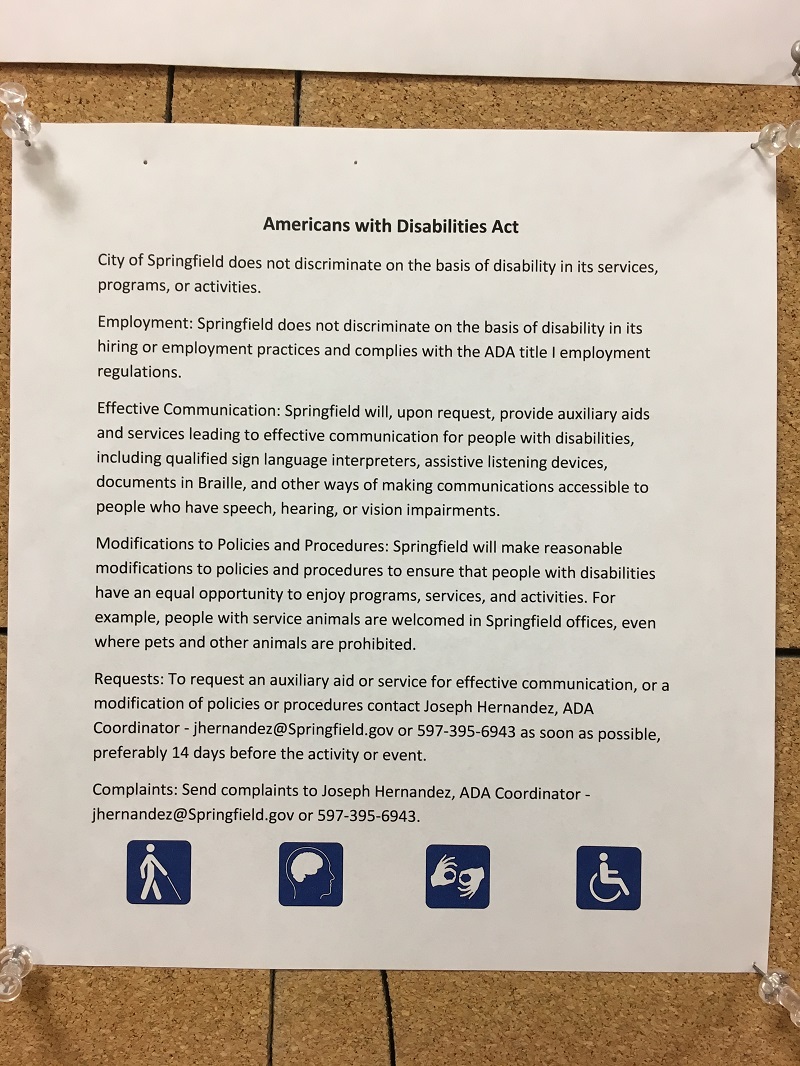Step 3 - Provide Public Notice
All public entities must provide information to the public, program participants, program beneficiaries, applicants and employees about the ADA and how it applies to the public entity. Here are some methods that public entities have used over the last 20 plus years.
Methods
-
Put the notice on the public entity’s website.
-
Include the notice in social media such as Twitter and Facebook.
-
Post the notice at facilities.
-
Publish the notice in local newspapers.
-
Broadcast the notice in public service announcements on local radio and television stations.
-
Include the notice in program announcements and applications.
The information must be provided in “alternative” formats so that it is accessible to people with hearing and vision disabilities.
Examples of Alternative Formats
-
Captioned public service announcements on television
-
Large print (recommend: san-serif typeface such as Helvetica or Arial, 18 point size. If an individual requests a specific point size, provide notice in that size)
-
Braille
-
Text file on a thumb disk or emailed to the person
-
HTML format on an accessible website
-
Audio recording
-
Radio announcement
Public entities must provide the information not just once, but on an ongoing basis. Changes should be made as necessary, for example when there’s a new ADA Coordinator.
Sample notice (long)
Americans with Disabilities Act
(Name of public entity) does not discriminate on the basis of disability in its services, programs, or activities.
Employment: (Name of public entity) does not discriminate on the basis of disability in its hiring or employment practices and complies with the ADA title I employment regulations.
Effective Communication: (Name of public entity) will, upon request, provide auxiliary aids and services leading to effective communication for people with disabilities, including qualified sign language interpreters, assistive listening devices, documents in Braille, and other ways of making communications accessible to people who have speech, hearing, or vision impairments.
Modifications to Policies and Procedures: (Name of public entity) will make reasonable modifications to policies and procedures to ensure that people with disabilities have an equal opportunity to enjoy programs, services, and activities. For example, people with service animals are welcomed in (name of public entity) offices, even where pets and other animals are prohibited.
Requests: To request an auxiliary aid or service for effective communication, or a modification of policies or procedures contact [ADA Coordinator name and contact information] as soon as possible, preferably XX days before the activity or event.
Complaints: Send complaints to [ADA Coordinator name and contact information].
Sample notice (short)
Americans with Disabilities Act
The [Name of public entity] does not discriminate on the basis of disability in its programs, services, activities and employment practices.
If you need auxiliary aids and services for effective communication (such as a sign language interpreter, an assistive listening device or print material in digital format) or a reasonable modification in programs, services or activities contact the ADA Coordinator as soon as possible, preferably XX days before the activity or event.
A grievance procedure is available to resolve complaints.
Upon request, this notice is available in alternative formats such as large print or Braille.
[ADA Coordinator name and contact information]
More on Notice
Public entities are required to ensure that interested people, including people with vision or hearing impairments, can obtain information as to the ”existence and location of accessible services, activities, and facilities.” This is an important but frequently overlooked part of the regulations.
Examples:
-
County B’s recreation department has four playgrounds. Two were renovated using the ADA Standards for Accessible Design and are accessible to children and adults with disabilities, two are not accessible. County B has information on the website concerning which playgrounds are accessible and which aren’t. The information is also included in the recreation department’s brochure.
-
State D’s museum has monthly tours that include sign language interpreters for people who are deaf. The museum will also try to get interpreters for any program with 14 days notice. This information is on the museum’s website, posted in the ticket purchase area and included in the museum’s brochure.
-
A City Managers’ office receives a call from a new resident who uses a wheelchair. The resident would like to know which city facilities are accessible (and which aren’t) and where the accessible entrances are. The City Manager's administrative assistant can provide that information because the ADA Coordinator created a list of the accessibility features in all facilities. The list is on the city’s website and the ADA Coordinator sent an email to all staff with the link.


User Comments/Questions
Add Comment/Question